#pipeline tubes
Explore tagged Tumblr posts
Text

#mans world#surf#surf life#surfing#soul surfer#soul#soul connection#pipeline#pipeline tubes#north shore surf#northshore local#locals only#barrel#endless summer
72 notes
·
View notes
Note
The fisherman render is the one in infinite wealth where you can check all the characters in the game and it’ll give you like a description about them and a render on the side. Pretty sure its somewhere in the settings

diggle . ....
#snap chats#sorry its so crusty i had to screenshot it from my capture card. he was lovingly cleaned up abuot as much as i could do#I DIDNT KNOW THIS EXISTED. BY THE WAY. thank you anon youve saved my doesnt-check-the-chara-bios ass#i thought i wouldve seen someone post this at some point also so vajerlkerjglkj BUT HE'S HERE NOW#excellent cause i was screaming trying to assemble refs for his fisherman outfit .. teehee .....#adding this to my render refs alongside y2 and y7 is so funny. what kind of pipeline is this#a tuna one perhaps ... heh .... or was it salmon I Think Those Were Salmon SORRY yk what im talkin bout tho#that fish tube.#anyway. Arms Crossed 😔
15 notes
·
View notes
Text


The Border of Hermes | Close to the Sun
#close to the sun#video game#video game photography#virtual photography#steampunk#pneumatic tubes#capsule pipelines#my screencaps#my edits#game screencaps#game screenshots#nvidia ansel
2 notes
·
View notes
Text
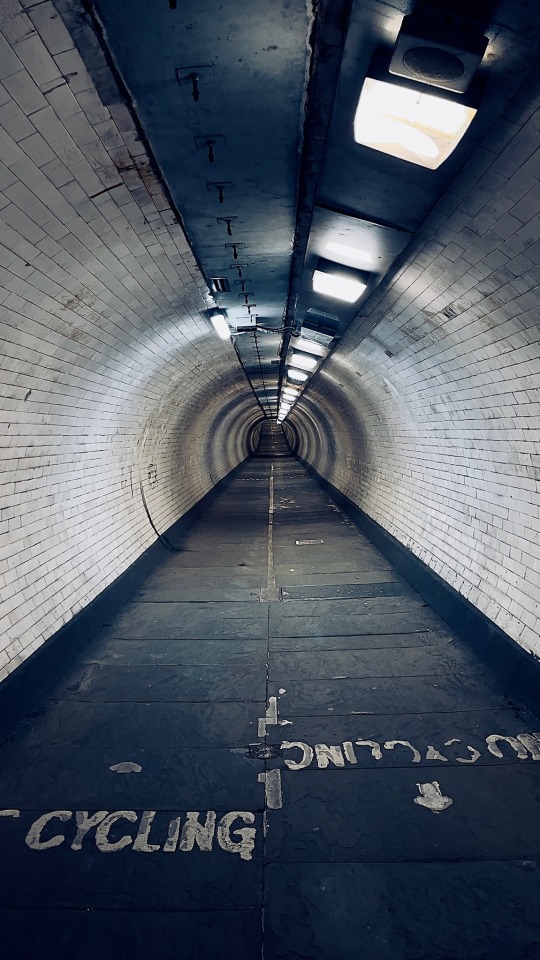
~ Canary Wharf —> Cutty Sark Tunnel
~ London
#iphonography#aesthetic#london#england#united kingdom#peaceful#lights#tube light#roads#road cycling#road photography#road signs#road travel#tunnel vision#theres a tunnel under ocean blvd#pipeline#bricks#wallpaper
8 notes
·
View notes
Text
Permanent Steel Manufacturing Co.,Ltd is a leading seamless pipe and welded pipe manufacturer & supplier serving diverse industries with multiple types, grades, diameters and lengths of pipe. For more information, please refer to: https://www.permanentsteel.com
4 notes
·
View notes
Text
Kirloskar Corrocoat : Revolutionizing Industrial Coatings with Precision and Innovation

In the heart of Kirloskarvadi, Kirloskar Corrocoat Private Limited stands as a beacon of innovation and quality in the manufacturing of advanced coating solutions. With a commitment to enhancing the durability and efficiency of industrial components, our company has carved a niche in the production of specialized coatings. Our offerings, meticulously designed to improve pump efficiency and protect against corrosion, are a testament to our dedication to excellence and customer satisfaction.
Pump Efficiency Improvement Coating: Enhancing Performance
Understanding the critical role of pumps in various industrial applications, we have developed a unique Pump Efficiency Improvement Coating. This cutting-edge solution is engineered to optimize the performance of pumps, ensuring they operate at peak efficiency. By reducing friction and wear, our coating significantly extends the lifespan of pumps, leading to substantial cost savings and improved operational reliability for our clients.
Impeller and Water Box Coating: Precision Protection
Our Impeller Coating is another hallmark of our innovation. Designed to shield the impeller from erosive and corrosive damage, this coating ensures consistent performance and longevity. Similarly, our Water Box Coating is specifically formulated to protect water boxes from the detrimental effects of corrosion, thereby maintaining the integrity and efficiency of cooling systems.
Corrosion Resistance Coating: Defying Degradation
At Kirloskar Corrocoat Private Limited, we understand the pervasive threat of corrosion to industrial assets. Our Corrosion Resistance Coating is meticulously developed to provide superior protection against various forms of corrosion, thereby safeguarding equipment and ensuring uninterrupted operation. This robust coating is ideal for a wide range of applications, including pipelines, storage tanks, and structural components.
Tank Internal and Tube Sheet Coating: Securing Storage and Heat Exchange Systems
Recognizing the challenges associated with the maintenance of tanks and heat exchangers, our Tank Internal Coating and Tube Sheet Coating solutions are designed to prevent corrosion and erosion. These coatings ensure that storage tanks and tube sheets remain protected against aggressive chemicals and high-temperature environments, thus preserving the quality and safety of stored substances and efficient heat transfer processes.
Epoxy Glass Flake Coating: Unmatched Durability
Our Epoxy Glass Flake Coating is at the forefront of our product line, offering exceptional durability and resistance to chemical and mechanical damage. Formulated with glass flake fillers, this coating provides a robust barrier against harsh industrial environments, making it suitable for a wide array of applications, from chemical processing equipment to marine structures.
Stove Dome Internal Coating: Withstanding High Temperatures
For applications that demand resistance to extreme temperatures, our Stove Dome Internal Coating is the solution of choice. This specialized coating is engineered to withstand the harsh conditions within stove domes, ensuring their structural integrity and operational efficiency are maintained even under the most demanding circumstances.
Our Modern Production Facility and Customer-Centric Services
At Kirloskar Corrocoat Private Limited, our state-of-the-art production facility in Kirloskarvadi is the cornerstone of our manufacturing excellence. Equipped with the latest technology, we produce a vast variety of glass flake-filled coating formulations based on epoxy, Iso-phthalic polyester, polyester, and vinyl ester. Our commitment to quality is matched by our dedication to customer service. We are fully equipped to execute both coating supply and application work with our in-house technology and facilities. Moreover, we offer the unique advantage of executing these services at our customers' locations, providing significant relief in terms of logistics.
In an era where durability and efficiency are paramount, Kirloskar Corrocoat Private Limited stands out as a partner of choice for industries seeking to enhance the lifespan and performance of their assets. Our comprehensive range of coatings, tailored to meet the specific needs of our clients, is a testament to our innovative spirit and unwavering commitment to excellence. Whether it's improving pump efficiency, protecting against corrosion, or ensuring the durability of industrial components, our solutions are designed to deliver unparalleled performance and value.
#Impeller Coating#Tank Internal Coating#Corrosion Resistance Coating#Tube Sheet Coating#FGD System Coating#Sea Water Pipeline Coating
0 notes
Text
Innovating Pipeline Rehabilitation: Pipe CIPP Lining Engineering Design Services as per ASTM F1216
In the dynamic world of plumbing and pipe rehabilitation, Cured-In-Place Pipe (CIPP) lining stands as a testament to the industry's progress and innovation. Pioneering a non-invasive, cost-effective, and efficient approach to pipeline repair, CIPP lining engineering design services have carved a significant niche in the industry. Adherence to the ASTM F1216 standard, set by the American Society for Testing and Materials, has further cemented the integrity and reliability of these services.
CIPP Lining: A Brief Overview
CIPP lining is a trenchless rehabilitation method that effectively repairs existing pipelines without the need for excavation. This process involves inserting and running a felt lining into a pre-existing pipe that is impregnated with a specially formulated resin. This resin is then cured, essentially creating a "pipe within a pipe."
The CIPP method addresses a wide array of issues, such as leaks, corrosion, root intrusion, and age-related wear and tear, without disrupting the landscape or the daily activities of businesses or households.
CIPP Lining Engineering Design Services
CIPP lining engineering design services employ advanced technology and innovative engineering principles to create effective, long-lasting solutions for pipeline problems. These services are critical to accurately assessing the damage, designing the CIPP liner, implementing the solution, and ensuring successful pipeline rehabilitation.
These engineering design services consist of various steps, such as:
Inspection: Before any design work can begin, the pipe's condition needs to be assessed using closed-circuit television (CCTV) inspection and other technologies. This inspection enables engineers to evaluate the damage extent and pinpoint its location.
Design: Based on the inspection, engineers design the CIPP liner considering factors such as pipe diameter, length, material, operating conditions, and the type and extent of damage.
Installation: This step involves inserting the designed liner into the damaged pipe and curing it using hot water, steam, or UV light.
Post-installation Inspection: The final step involves inspecting the rehabilitated pipe to ensure the CIPP liner is correctly installed and functioning as expected.
The Role of ASTM F1216
The ASTM F1216 - "Standard Practice for Rehabilitation of Existing Pipelines and Conduits by the Inversion and Curing of a Resin-Impregnated Tube," is a globally recognized standard that guides the CIPP lining process. It prescribes the material requirements, resin preparation, inversion process, curing method, and testing techniques for CIPP lining.
Adherence to this standard ensures that the CIPP lining engineering design services meet the necessary quality and safety standards. It also guarantees the end product's durability, structural integrity, and optimal functionality.
Benefits of CIPP Lining Engineering Design Services
CIPP lining engineering design services offer numerous benefits, such as:
Durability: CIPP linings have a lifespan of up to 50 years, making them a long-lasting solution.
Non-disruptive: Being a trenchless method, CIPP lining causes minimal disruption to daily activities and avoids damaging landscapes or structures.
Versatility: CIPP lining is suitable for various pipe materials and diameters, making it a versatile solution.
Cost-effective: CIPP lining eliminates the need for excavation and extensive manual labor, significantly reducing costs.
Efficiency: The entire CIPP lining process can often be completed in a day, making it an efficient solution for pipeline rehabilitation.
Among the many engineering firms providing CIPP lining design services, Little P.Eng. Engineering has distinguished itself as a leader. Leveraging a combination of industry expertise, innovation, and adherence to the ASTM F1216 standard, the firm has been able to provide high-quality, efficient, and reliable pipeline rehabilitation services.
Firstly, the firm's deep-rooted understanding of pipeline systems is undeniable. They have a team of dedicated professional engineers (P.Eng.) who bring a wealth of knowledge and experience to the table. Their engineers understand the intricacies of different pipeline materials, their response to various environmental conditions, and potential failure modes.
Their specialization in CIPP lining, a modern, trenchless pipeline rehabilitation method, has allowed them to handle a broad range of pipeline issues effectively. Whether it's handling minor leaks, major corrosion issues, or extensive root intrusion, their team is adept at designing and implementing the appropriate CIPP lining solution.
Adherence to the ASTM F1216 standard has been a cornerstone of Little P.Eng. Engineering's approach to CIPP lining engineering services. This commitment ensures that the resin preparation, inversion process, curing methods, and testing techniques used meet the highest quality and safety standards. It also guarantees that the resulting CIPP lining possesses the durability, structural integrity, and functionality necessary for long-term pipeline performance.
Moreover, Little P.Eng. Engineering is known for its innovative approach. They harness the latest technologies and engineering principles to improve the effectiveness and efficiency of their CIPP lining design services. This includes using state-of-the-art CCTV technology for initial pipeline inspection and advanced curing methods to ensure optimal resin curing.
Lastly, the firm's dedication to customer satisfaction sets them apart. They understand that every client has unique needs and circumstances, and they strive to provide tailored solutions that are both effective and cost-efficient. They also prioritize transparent communication, ensuring their clients understand every aspect of the rehabilitation process.
In conclusion, Little P.Eng. Engineering's deep expertise, innovative approach, and commitment to customer satisfaction make them a preferred choice for CIPP lining engineering design services. Their rigorous adherence to ASTM F1216 further assures clients that they are receiving high-quality, safe, and durable pipeline rehabilitation solutions. The combination of these factors positions Little P.Eng. Engineering as a reliable partner in the industry, capable of effectively addressing a wide array of pipeline challenges.
Conclusion
In the realm of plumbing and pipeline rehabilitation, CIPP lining engineering design services as per ASTM F1216 have proven to be a game-changer. By providing a non-invasive, cost-effective, and efficient solution to pipe repair, they have redefined traditional methods. As the industry continues to innovate, the importance of these services and the ASTM F1216 standard's adherence will only grow, paving the way for a future where pipeline problems are no longer a headache but a manageable, efficient process.
Read More:
Innovating Pipeline Rehabilitation: Pipe CIPP Lining Engineering Design Services as per ASTM F1216
Pipeline Rehabilitation Engineering Design Services as per ASTM F1216 Using CIPP and PVC
Little P.Eng. Engineering For CIPP Liner Design As Per ASTM F1216 Using Finite Element Method
Revolutionizing Pipe Rehabilitation: Little P.Eng. Engineering's Mastery of CIPP Liner Design via Finite Element Method in Accordance with ASTM F1216
Tags:
Meena Rezkallah
Little P.Eng. Engineering
ASTM F1216
Professional Engineers
Pipe Rehabilitation
CIPP Lining
Engineering Design Services
Trenchless Technology
Pipeline Repair
Cured-In-Place Pipe
Resin-Impregnated Tube
Plumbing Industry Innovation
Pipe Lining Solutions
Pipeline Inspection
Durability and Structural Integrity
Cost-Effective Pipeline Solutions
Engineering Services
Pipe Rehabilitation
Located in Calgary, Alberta; Vancouver, BC; Toronto, Ontario; Edmonton, Alberta; Houston Texas; Torrance, California; El Segundo, CA; Manhattan Beach, CA; Concord, CA; We offer our engineering consultancy services across Canada and United States. Meena Rezkallah.
#Meena Rezkallah#Little P.Eng. Engineering#ASTM F1216#Professional Engineers#Pipe Rehabilitation#CIPP Lining#Engineering Design Services#Trenchless Technology#Pipeline Repair#Cured-In-Place Pipe#Resin-Impregnated Tube#Plumbing Industry Innovation#Pipe Lining Solutions#Pipeline Inspection#Durability and Structural Integrity#Cost-Effective Pipeline Solutions
0 notes
Text
Tips for maximizing tube, pipe mill efficiency (Part II)
Finding, Reducing, Eliminating Bottlenecks
The pace at which the strip moves through the mill, from one station to the next—breakdown, forming, welding, sizing, and straightening—sets the pace for everything else. The mill’s reference speed is the maximum speed at which it makes a properly formed tube with a robust, durable weld.
“The limitations often are in the entry and exit areas,” said Nelson Abbey, director of Abbey Products at Fives Bronx Inc. Efficient mill operations can be hampered by material handling and coil joining at the entry end; cutting the product to length and getting tubulars off the mill likewise tend to impose limits at the exit end.
Getting the Coil Into the Mill. If the coils are long, butt welding the outgoing coil to the incoming coil might take place every 15 or 20 min., and the operator gets a break between each one, Abbey said. If the coils are short and take only 5 min. or so to work their way through the mill, the end-joining process is likely to be the mill’s productivity limit. Longer coils mean less frequent mill stoppages and put less stress on the operator, he said.
For some applications, the butt weld serves a second purpose. For long lengths of coiled tubing, which can be miles long, the butt welds are a product feature and must be just as durable and leakproof as the longitudinal welds. Although an arc welding process is traditional, laser technology is making inroads relative this application, said Kevin Arnold, Midwest sales manager for IPG Photonics. The benefits are the same as those for making the longitudinal weld with laser technology, especially the minimal heat input and minimal ensuing distortion.
“The lower heat input and smaller heat-affected zone create a more durable weld,” said Mark Wagner, vice president of sales for Guild International. “A hard, brittle weld is prone to breaking as the joint moves through the mill. The tension can be enormous and often is more than enough to break the weld. When using a laser to join the coils, Guild has found that weld breaks are greatly reduced, and that the line can get back up to speed much quicker.”
“Another issue is the weld bead’s thickness,” he said. “Arc welding processes typically leave a thick weld bead. The additional thickness accelerates the wear on the roll tooling and other equipment, like inline tension levelers, so the weld has to be treated with either manual or automatic milling to reduce the weld bead, so the thickness is consistent. Laser welding doesn’t leave a raised weld bead, so it eliminates postweld treatments such as milling.”
The initial process, making the butt weld, also tends to go more quickly with laser welding than arc welding processes, he added.
Make It, Cut It, and Move It Out. When all is nearly said and done on the mill, the focus turns to the cutoff process. Some products simply take more time to cut than others. Even a product that usually is made at a fast rate and is easy to cut—say, a light-wall, small-diameter tube—can slow a mill down if the final cut lengths are short. The saw has to move at the same speed as the tube to make the cut, return to its starting position, then get back up to the mill’s speed to make the next cut. As the cut lengths decrease, the saw’s accelerations have to become increasingly faster to keep up.
Beyond the cutoff, carrying out finishing as part of the production process can create a bottleneck.
“Flushing the chips out of the tube, facing, and bundling them are additional processes that usually slow down a line,” Abbey said. The problem is that these run in different ways, Abbey explained.
“A mill runs most efficiently when it’s running consistently at a constant speed,” he said. “Finishing operations are start-and-stop processes.” On the surface, the difference is the pace of the mill versus the pace of the finishing steps, but it goes deeper.
“Every line stop creates at least one length of scrap,” Abbey said. Another drawback is the time it takes to ramp up the mill. “You don’t press a button and get back to full speed,” he said. “For typical mills, it can take 10 minutes or so.”
Depending on the system’s design, which often is influenced by limited floor space and obstructions such as building columns, such a connected system might just be inherently inefficient. Designing a generous buffering capacity between processes that run at substantially different rates is a good solution, depending on handling complexity. But if it’s impossible to include a buffer, or if the buffer is undersized, a lower overall production rate is inevitable.
It seems counterintuitive to connect a mill to finishing equipment, but indeed many mills are set up in this way. Depending on the product and how fast it runs through the mill, this setup isn’t detrimental to operational efficiency. For example, among mills designed to make products according to American Petroleum Institute specifications, about half of them can be connected to the finishing system with no effect on productivity, Abbey said. However, many such setups would run faster if they were disconnected.
What are the benefits? Such a setup uses less labor power than a disconnected system, and it takes up a smaller footprint than a disconnected setup, so many tube and pipe producers are willing to sacrifice some line speed and possibly lower overall product rates for these benefits.
On some mills, processes such as flushing and bundling are manual, which can be even more detrimental. In some cases, these end-of-mill processes bring the mill speed down by half, Abbey said. It’s a tradeoff—the company makes a smaller capital investment and brings in less revenue—but it can have unintended consequences. The operators become accustomed to the mill’s pace, and even if the company upgrades to automated flushout and bundling, it can have a lot of difficulty with the return on investment. After learning to do the job at 200 ft./min., the operators simply aren’t comfortable operating a mill that runs at twice that pace.
Changeovers
Selecting the right tooling for the job seems like an obvious first step, but mixups do happen. Mounting the wrong tooling—say, substituting tooling with a modified edge break for tooling with a standard edge break—makes it more difficult to make good product, and it compromises the tooling life, said Warren Wheatman, vice president of T&H Lemont’s Tooling Business Unit. The same goes for mounting the tooling correctly. When tools are reconditioned, the company that did the grinding usually provides a set of bearing block shims for proper mounting. In many cases, the shims get misplaced or their purpose isn’t understood and they are discarded. The tooling can’t do its job properly without the shims.
Getting the tooling aligned is the next step. Automated tool positioning devices are available, but many tube and pipe producers still rely on manual setups.
“Motorized adjustments with position feedback at each pass can help the setup go much faster, leaving only a small amount of manual tweaking to finalize the setup,” Abbey said. The same goes for the settings of the straightener, he said. The only caveat is that the maintenance staff has to be knowledgeable on how every device works and how everything is wired, and the company has to keep sufficient spares of every critical device in its inventory. Otherwise, just one bad component like an encoder can slow the process substantially, especially if used in an automated quick-change mill.
Does a tube producer need quick-change hardware, electronic positioning devices, and other hardware to reduce its changeover time? No. According to Abbey, good procedures and a motivated crew can cut changeover time nearly in half. He cited one 10-in. mill that had standard equipment and no quick-change features or setup assistance of any sort. While most such mills need five to eight hours for a changeover, one company with a motivated crew equipped with well-documented procedures could get it done in three and a half hours.
If a mill can accommodate rafts—subplates with tooling mountings—it can cut the mill’s downtime by a large amount, frequently up to 75%. It still takes time to do the changeover, so the company still needs the labor to change out the tooling on the raft, but it does so while the mill is still running and making money.
Of course, planning goes into this like it does everything else. Michael Strand, president of T&H Lemont, suggests three rafts per mill. While one raft is on the mill and making money, a second raft can be prepped with tooling for the next run. The rafts themselves have a large number of moving parts, so the third raft can be set aside for a teardown, inspection, and repairs if necessary.
“Threading is also a candidate for improvement on some mills,” Abbey said. “When threading a new strip through the mill, it’s common practice to jog the mill, starting and stopping numerous times. Once threaded, the mill is then typically run for a short distance to check the weld and do sizing adjustments, which generates a substantial amount of scrap. Simple improvements in this area can be obtained by streamlining the steps and by including interlocks with the welder so it can weld and jog at the same time.”
“It would generate less scrap if the company that made the welding power supply would change the controls so the mill could jog the material forward, weld, and scarf simultaneously,” he continued. “On large mills this is a necessity, and it really reduces the amount of scrap generated at each startup.”
Bringing It All Together
The essence of tube or pipe mill efficiency hasn’t changed, but in times like these, it’s more critical than ever. The revenue a mill generates while it’s running is always offset by the losses it incurs when it’s not, but times such as these seem to amplify the losses. Steel prices are higher than normal, and some materials simply aren’t available, so keeping the mill running and minimizing scrap are two considerations that are in sharp focus right now.
Best Practices. These industry experts, each of whom has decades of experience in the field, provided informed insights and perspectives regarding best practices:
“Every changeover involves downtime and scrap, and traditionally these are the two areas where tube and pipe producers can make the biggest gains,” Abbey said. “Every mill supervisor needs to study their changeover procedures.”
“It’s important to perform every maintenance action according to the schedule and document everything,” Strand said. Track every action on the mill, including the number of feet of product made by each set of roll tooling during each run, to stay on top of mill maintenance from a big-picture, years-long perspective.
“It’s helpful to use a status board or checklists that show each major step described clearly and concisely,” Abbey said. “Whether it is a changeover or a routine maintenance procedure, such as inspecting tooling, using checklists adds to consistency and efficiency,” Abbey said.
Using automated systems and devices to assist with mill setup can keep changeover time to a bare minimum. Abbey cited one special, automated mill that had its changeovers down to a science, relying extensively on such hardware, and it achieved consistent 15-min. changeovers. In that case, it was necessary to keep operator intervention to a minimum.
“Tube and pipe producers need to be careful how they use the mill,” said Stan Green, general manager for SST Forming Roll Inc. “Many of the materials available these days are much harder than common carbon steels, and the steel producers seem to introduce stronger materials all the time,” he said. Using a mill designed for carbon steel with a 50,000-PSI minimum yield strength to process 80,000-PSI material is going to accelerate the wear on every component on the mill and likely will break something—and sooner rather than later.
Inspections, maintenance, alignments, and yield work together, especially with tooling and roll stands.“The weakest point is the point that moves [out of position],” Green said. He cited a tiny bit of movement, anything more than 0.010 in., as too much movement. “Proper tooling position is important for a consistent process and to maximize yield, but you can’t keep the tooling in the right position if the bearings and shafts are worn,” he said.
Budgetary Matters. Regular maintenance is always important. It’s a critical issue day after day, week after week, month after month, year after year. Following the suggested maintenance schedule for every item isn’t more important when runs are shorter and changeovers are more frequent, but these activities are more likely to be delayed or even overlooked during difficult times.
“When times are good, tube and pipe producers hesitate to stop production for maintenance,” said Michael Strand, president of T&H Lemont. “When times are tough, they don’t want to spend the money.” And although many mills are running full-tilt right now, a sign of good times, some of the business conditions are tough—especially the sky-high cost of raw materials and the less-than-reliable supply chains, fallout from the pandemic.
“More money spent on the raw material and more time spent on changeovers means less money and time for scheduled maintenance,” said Dan Ventura, president of Ventura & Associates. It’s not just a matter of spending money, but spending it wisely. It takes high-quality machinery and consumables to make high-quality products, and better investments can pay off.
“When buying tooling, many tube producers work right off the quotes and make decisions based on price,” Strand said. If it’s not a trustworthy tooling provider, it’s impossible to know if the tooling is made to the right design for your mill, made from the proper alloy, and if it was heat-treated properly.
The same goes for the ferrite used in the impeder, said John Holderman, general manager for EHE Consumables.
Few would go so far as to research something that many would regard as a minute detail, but ferrite varies in grade, which equates to its capacity to do its job. To provide the best use of electrical energy, the ferrite must have three characteristics: low losses, high permeability, and high saturation of flux density. For durability, it needs construction methods and binders that resist heat.
The same goes for everything else on the mill. Frugality is one thing, but taking that too far can mean dedicating disproportionate time and effort on repairs and incurring more downtime than necessary as the equipment ages.
Breaking the Speed Limit. If a company does adhere to every best practice, where can it go from there? For those who are prepared, there is one more boundary to be pushed.
“When everything is dialed in, the operator has one more thing he can do to maximize throughput,” Abbey said. “A motivated operator can run the mill a little faster than he’s accustomed to.” Abbey acknowledges that this means the operator has to work outside of his comfort zone, and this isn’t easy, but this is one last area for productivity gains, and perhaps the only way to find out what the mill really can do.
0 notes
Text
for everyone asking me "what do we do??!??!"
The Care We Dream Of: Liberatory and Transformative Approaches to LGBTQ+ Health by Zena Sharman
Mutual Aid: Building Solidarity During This Crisis (And the Next) by Dean Spade
Cop Watch 101 - Training Guide
The Do-It Yourself Occupation Guide
DIY HRT Wiki
The Innocence Project - helps take inmates off of death row
Food Not Bombs
Transfeminine Science - collection of articles and data about transfem HRT
Anti-Doxxing Guide for Activists
Mass Defense Program - National Lawyers Guild
How to be part of a CERT (Community Emergency Response Team)
Understanding and Advocating for Self Managed Abortion
The Basics of Organizing
Building Online Power
Build Your Own Solidarity Network
Organizing 101
How to Start a Non-Hierarchical Direct Action Group
A Short and Incomplete Guide for New Activists
Eight Things You Can Do to Get Active
Palestine Action Underground Manual
How to Blow Up a Pipeline by Andreas Malm
Spreadsheet of gynecologists that will tie your tubes without bothering you about it
COVID Resource Guide
Mask Bloc NJ (find one near you, these are international!)
Long Covid Justice
Donate to Palestinian campaigns (2, 3, 4)
Donate to Congolese campaigns (2, 3)
Donate to Sudanese campaigns (2, 3)
2K notes
·
View notes
Text
born to be silly forced to suffer (doing uni work for a degree i picked)
#something something shouldn't have picked an engineering course#i dont want to design pipelines!!!! i want to make pretty colors appear in test tubes!!!
0 notes
Text

From just “playfully gaining a little jiggly tummy” to realizing you’re not escaping the twink fattening pipeline~ 😈🥵🤭
Brb now going to think about someone strapping a tube to my mouth and me mindlessly swallowing 😳
#gay gainer#make me fatter#fat twink#stuffing#weight gain#chubby belly#fat kink#gay feedee#chubby boy#gay weight gain#gay bhm#twink weight gain#chubby twink#chubby gainer#ex twink#twink belly#chubby gay#fattening#forced fattening#male weight gain#bhm gainer#malefeedee
630 notes
·
View notes
Note
Is.. is it time.
Gently sets Bell down for Doll David. I am not sure how confusing this will get considering this is “chime” pipeline but….. you know :3. Just pretend it didn’t happen in “bell” timeline. I’m so smart.
Fuck it we ball . Time to give this man more trauma or do we call this fixing him, idk !
Bell is set in what seems more like a conference room turned lab, it's looks semi recently repaired. Test tubes filled with weird liquids, devices strewn about, circles and chalk on the floor, and David sat at a desk leaning over a project not having noticed him yet.
58 notes
·
View notes
Text
the water heater
lilac, chapter three


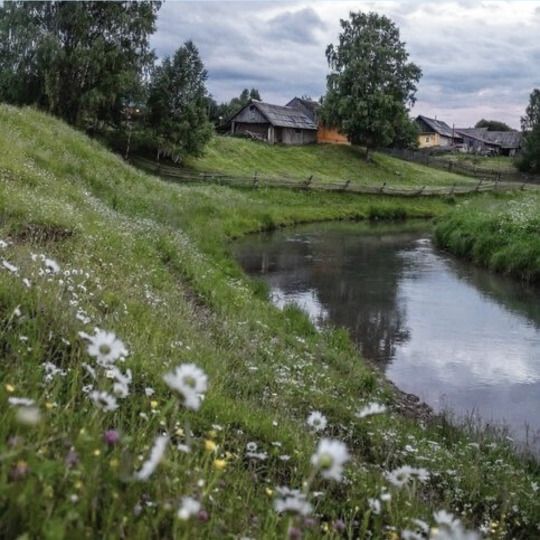






a/n: ...don't ask me how late it got when i wrote this.... i was on a roll that day and time just turned into a weird soup.
summary: “Dad, please, for the love of god, just–,” you spun around, though the unexpected figure that stepped into the low light caused your fury to fade away in an instant, “oh, uh, you’re not–, uhm, h-hi.”
warnings: lumberjack!frank castle x reader, lumberjack AU, pete castiglione era, past domestic violence, crazy ex trope, slow burn, renovating an inn, totally inaccurate description of tinkering with a water heater just for the sake of making them fall in love
word count: 1137
∼ gentle reminder that feedback, but especially reblogs are the way you support writers on here ∽
previous chapter | series masterlist | next chapter
masterlist | join my taglist

“Well, maybe if you just–”
“Dad! Just–…” you swallowed the rest of the heated statement that nearly escaped your lips, mentally counting to three before glaring back at the man who was breathing down your neck, “do you remember when I was 12 and you had the clever idea of attempting to install that new sink in room 5?”
Already knowing where this story was gonna go, Harvey quietly replied, “…yeah…”
“And just who, pray tell, fixed it after you made the pipes uncontrollably spurt out water, consequently flooding the entire room?”
“…you did…”
“That’s right,” you sucked on another tense breath before continuing, “so, unless you’ve somehow improved that skill since then, which, I’m sorry dad, but I highly doubt that you have, please, just let me handle it alone.”
“…alright, fine,” he ultimately backed off, nearing the basement stairs, “but I’ll be right up by the front desk if you need me.”
“I won’t,” you called over your shoulder as you redirected your attention to the hopeless pipes, “but thanks.”
Letting the illuminated spot from the small flashlight clutched in your palm guide your vision, you checked each and every rusty tube.
After too many pokes and prods, you finally found the source of the problem. Stepping over towards the main pipeline you bend down and reached through tickling cobwebs to turn the paint-chipped knob clockwise, shutting all of the water off.
Before your spine managed to straighten back out, you felt your blood begin to boil as you heard the sound of heavy footsteps once again ascending the crooked staircase.
“Dad, please, for the love of god, just–,” you spun around, though the unexpected figure that stepped into the low light caused your fury to fade away in an instant, “oh, uh, you’re not–, uhm, h-hi.”
“Hey,” Pete’s deep voice echoed throughout the dim space, sounding the way that hot chocolate felt.
“Uh, not that I’m not thrilled to see you here, in my basement of all places, but, um, what are you–, what can I help you with?”
“Nothing ma'am,” he took a step closer, “it’s what I can help you with.”
“Excuse me?”
“Well, Harvey sent me down here to take a look at something.”
“Oh, did he now…” that was the last you needed in order to lose your patience.
“Yeah,” Pete’s eyes tracked your form as you riffled through the open metal toolbox and yanked out a wrench.
“Well,” you huffed as you began to loosen the various hexagon-shaped fittings snug on the pipes spiderwebbing out from the bulky water heater apparatus, the labour of the task presenting itself in your vexed voice, “you can tell my dad that I’m still just fine and don’t need any help!” the tool on your palm then inadvertently slammed against one of the pipes, the clanging and therapeutic blow snapping you enough out of your ire to take a step back. Squeezing your eyes shut a moment, you let out a deep sigh before parting your lips once more to speak, “I’m sorry, it was very kind of you to offer your help, but I’m okay.”
Fully expecting him to just take off, his stationary stance caught you off guard, “so, the water heater’s acting up?”
“It’s fucking ancient, that’s what it is,” you replied as you returned to twist the remainder of the fittings, “should have updated it long ago, but no, no, that never happened,” you continued to grumble mostly to yourself at this point, “of course it’s much more fun to let me handle it down the line when the hot water outlet is completely rusted over and clogged up to the point of no return, you know, that’s just so much more fun…” your words then faded away as you attempted to turn a knob that in no way wanted to corporate.
Quietly cursing underneath your breath, you tried to put all your weight into it as you strained to turn the stuck fitting.
But just then, from out of nowhere, you felt the wrench begin to turn, but that victory wasn’t the only thing you suddenly felt. Engulfing your own, the comparatively massive hand of Pete enveloped yours as if it wasn’t even there to begin with, helping you turn it as though the metal was made out of butter.
Blinking up at him after it finally twisted completely, his intimidating stature seemed even more towering up close.
“Uh,” you slipped your hand out from under his calloused palm, “thank you…”
“No, problem,” you promptly whirled around to avoid his piercing gaze, busying yourself by riffling through the toolbox without any purpose whatsoever, “so your old man’s not helping you out in renovating this place?”
“Well, he’s brilliant at a lot of things, but those skills in particular have never really been in his bailiwick–, wait…” you kept your back turned to him as you asked, “how do you know that I’m renovating?”
“People in this town like to talk, a lot,” he breathed out the essence of a laugh, “and that includes your father.”
“Ah, okay…”
Spinning around once again, you kept your eyes steadfast on the dusty pipes, though after what only felt like a second, Pete unexpectedly proposed, “hey, what do you say I lend you a hand?”
“What?”
“Well,” hands clasped together in front of him, the digits on one of them dug into the palm of the other as he spoke, “I’m no stranger to fixing things, so it might help make it fly by a bit faster than if you try and get through it all on your own.”
Unable to detect if this was just some strange joke or not, you verified, “I’m sorry, but are you legitimately offering me your help in renovating this place right now?”
“Yes.”
“Seriously?” you bellowed a little louder than you’d intended, earning just a small nod from him in confirmation, “I–…” you blinked back at him, downright dumbfounded, “that’s incredibly generous of you, but I can’t really afford to hire you right now…”
“Oh, I’m not asking you to hire me, just let me help out a bit.”
“Pete, I can’t let you do that, not without any form of compensation.”
“Well, then just pay me in free coffee till it’s done,” he attempted to joke, though it didn’t manage to crack a smile on your lips.
“This is not funny, Pete.”
“No, it’s not,” he continued, still in a startlingly light-hearted tone, “you clearly don’t know yet just much coffee I tend to drink on average every day,” seeing you not budge an inch, he then dropped the attempt with a gentle nod, “fine, how about we just take a look at a price at a later date? Decide on it later when it’s all done, and you start making a profit again?”

© 2023 thyme-in-a-bubble
#lea’s writing#lilac series#lumberjack!frank castle#frank castle x reader#frank castle imagine#frank castle x you#frank castle x y/n#frank castle x female reader#frank castle x fem!reader#frank castle x f!reader#frank castle fic#the punisher fic#frank castle fanfiction#the punisher x reader#frank castle fluff#frank castle series#lumberjack au
547 notes
·
View notes
Text
How to Blow Up a Pipeline (or: why the climate movement is failing)

Okay, talking about politics this week, let me talk about this amazing book that you all should read, because it is not that long and it really makes a lot of good points. I found this book through the Philosophy Tube video a couple of years ago.
So, what is this book about?
To put it lightly: It is about how the climate movement is failing over their refusal to use any sort of violence or sabotage. And it is about the ethics of violence.
Which is not only important to the climate movement, but all sorts of progressive movements. Which again brings me back to what I talked about so many times before: Being against a revolution is being against change. And the left in general has a problem with idealizing parcifism to an unhealthy degree.
Let me explain: The left has in general very much drunken the cool-aid to accept that there is no violence happening right now, so using violence against the perceived non-violence is wrong. But that entire idea is bullshit.
Letting people starve, while there is enough food around for everyone, is a form of violence.
Letting people die of preventable deseases, because they cannot afford health care, is a form of violence.
Letting people die in extreme weather, just so that a few people can profit from fossil fuels... Well, that is a form of violence, too.
But left people - especially white, leftists - have very much accepted that non-action can never be violence. So, not giving someone the food they need, cannot be violence in their point of view. So, using violence to act against the system that lets this happen again and again... that is "out of proportion" in their point of view. Because they do not suffer themselves, they do not perceive the violence.
The book talks about how specifically the climate movement refuses to use any form of violence, even just in the form of sabotage, in which no human would ever come to harm. Which is why the title is "how to blow up a pipeline". Because blowing up a pipeline would harm those, who profit from climate change, from the fossil fuels. The book is also about how the climate movement then goes ahead to appropriate civil rights leaders, without really understanding the context they were in. Because they will name Martin Luther King, Ghandi or Nelson Mandela as examples of people who succeeded with non-violence, without acknowledging that all three of those leaders were leaders of a non-violent group that closely associated with a violent movement that aimed for the same changes. And through that contrast - of a violent group and a peaceful group with widespread support - the people in power were forced to make a move to work towards them to some degree.
Now, technically the book involved nothing new to me. Because I thought about this topic - about the ethics and visuals of violence - for a long while now. It also is fitting with the entire French Revolution thing I spoke about on Sunday. Because we see it in the judgement of the French Revolution as well. On how there a) was a peaceful group first, and b) the violence that happened, happened in response to other violence.
And as the book points out: The fossil fuel industry does not care. As a German I know this too well. And I think it is no accident that a lot of the examples of this in the book come from Germany. Our climate movement here is very tame. It is mostly just kids (like people between their teens and early twenties) doing protests in forms of blocking streets and the likes. Yet, the fossil lobby and those in power will call that "terrorism" and will call that one time when folks tore down a fence at the coal mine as "extreme violent behavior". They are doing massive and at times violent police action against those KIDS, who organize the street blockades. Having thrown literal teenagers into prison for at times weeks, before judges intervened clearly saying that "the kids have done nothing illegal".
They do not care that the movement is non-violent. And the movement will not get anywhere, without some group standing in and doing some damage to the most important thing those people can think of: Their base line.
#how to blow up a pipeline#climate movement#fridays for future#climate action now#anarchism#anti fossil fuels#protest#solarpunk
242 notes
·
View notes
Text
More IRL Lego Lancer!

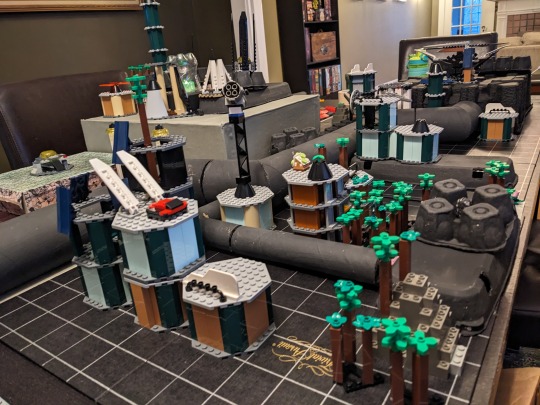
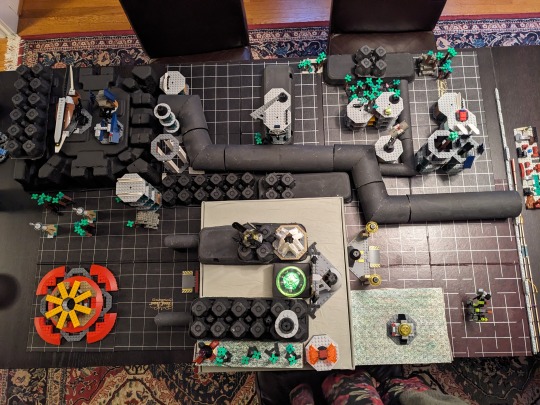
We played the Tomb of Delios one-shot by Katherine Stark. Some NPC comp / sitrep spoilers ahead.
I used the backs of old trivial pursuit boards for grids, egg cartons, poster tubes, and a big Roomba box + insert for terrain.
I coated the cardboard with this flour and glue paste recipe I found on youtube.
I found a bunch of cheap-ish large lego octogons and walls online for the modular buildings, then greebled them with misc urban details I collected from my local bricks & minifigs bulk by-volume bins.

Our PCs were a Swallowtail artillery (callsign Bandit; an SSC plant in the union auxilliaries), Störtebeker striker (callsign Roadkill, silver-nanite kintsugi'd mechromancer), and Black Witch support (callsign Egret, disgraced princess (gotta be one of my favorite genders)).
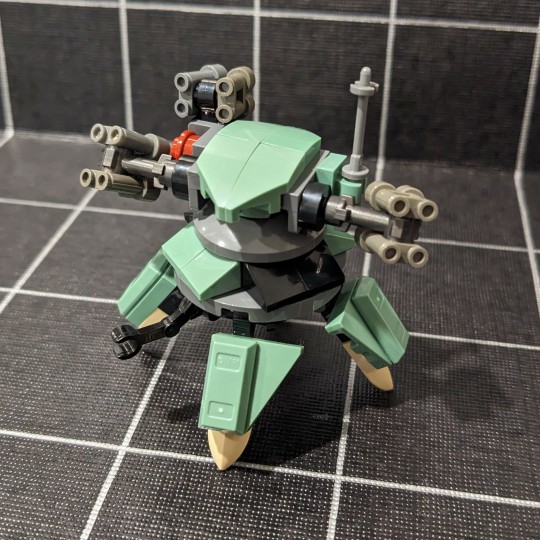
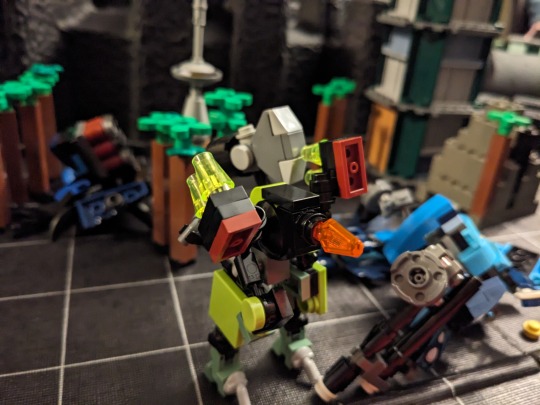

The elite cataphract ended up playing trapdoor spider for most of the game; hiding in a magical healing forest (thank u support o7) and grappling PCs back into the forest with it.
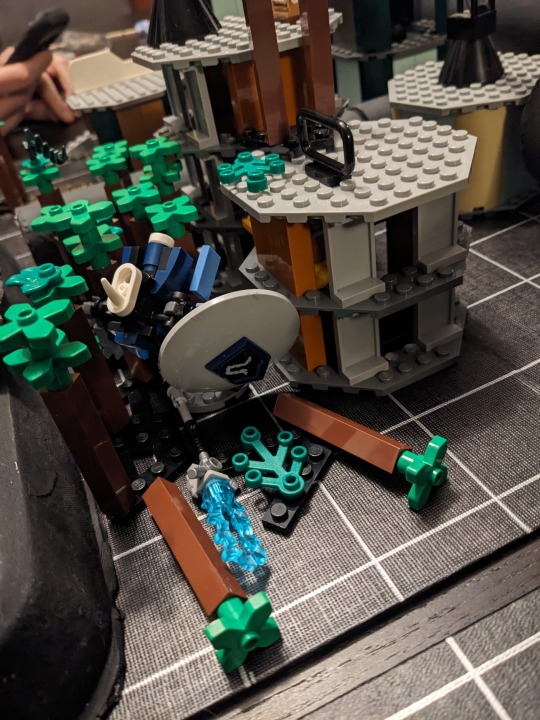
Its scariest turn was popping out, structuring the Bandit and destroying his siege stabilizers, and lassoing it back into the forest. Egret came to the rescue and finally did the cataphract in with perimeter command plate/impact lance/crit thrown tactical knife overwatch combo.
The Swallowtail never took any voluntary movement after deploying its siege stab round 1, but between rainmaker knockback, the aforementioned trapdoor spider incident, and allied ferrous lashes, and a few rams, it was pingponged around the map pretty significantly.
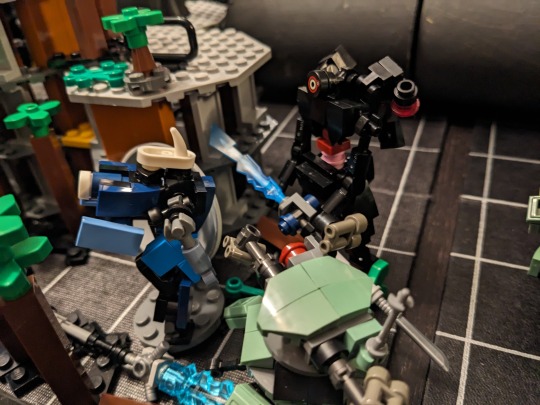
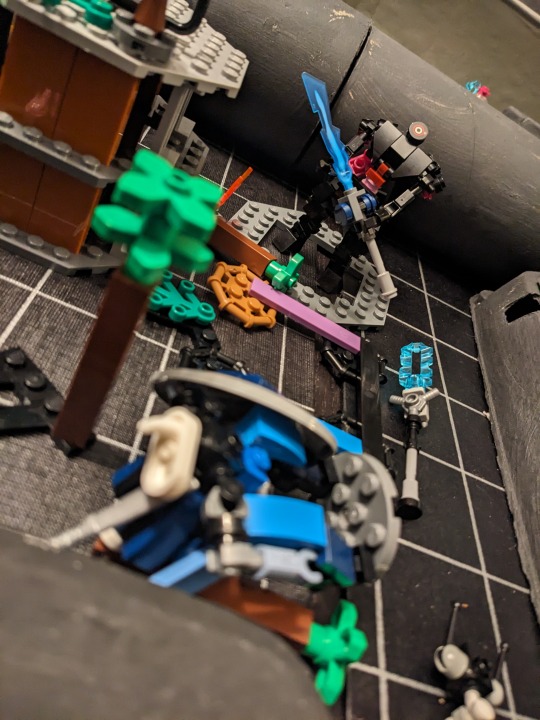
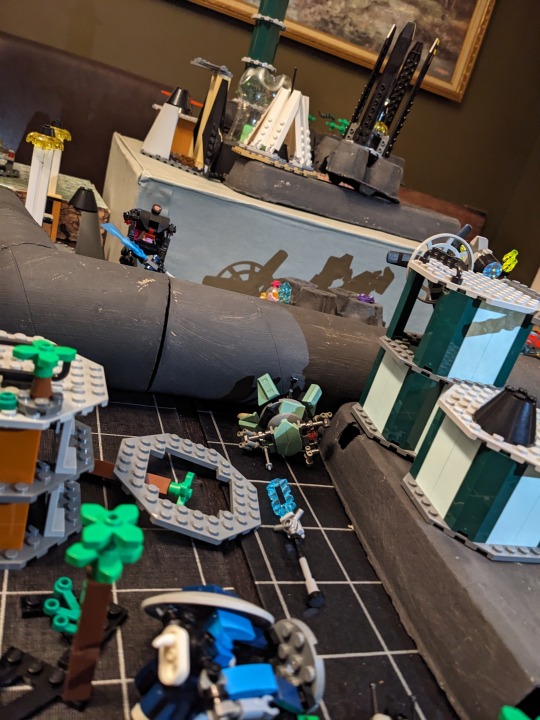
"Come out Rainmaker, I just want to talk."
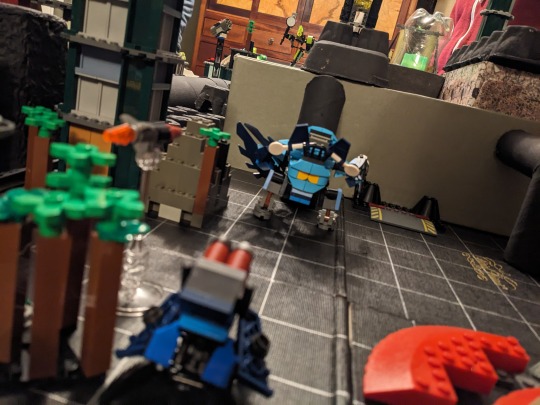
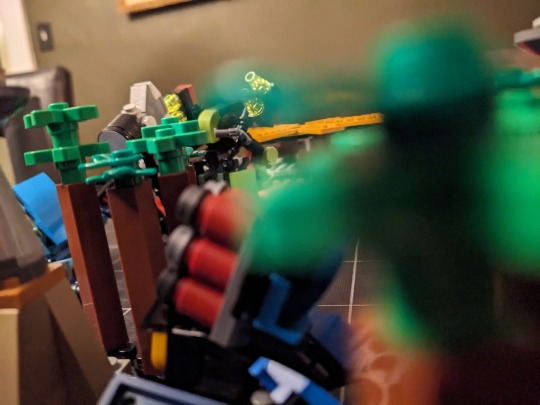
The final threat to the objective was when a bastion clambered up onto the pipeline to contest them. The Störtebeker (whose mini was having trouble standing up on the pipeline) pulled an indiana jones and just shot it down.

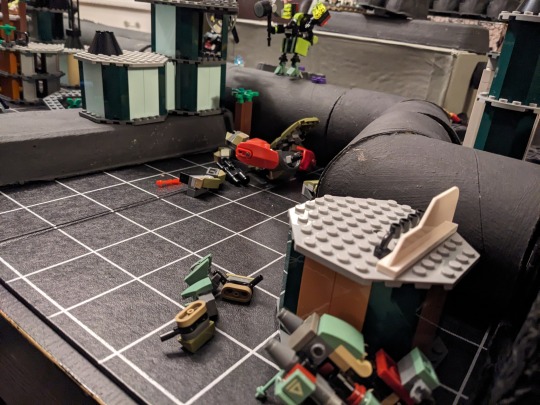
For the pre-battle narrative section, I made two 4-step clocks out of lego and a minimap as the party visited various districts of the city. Both were totally unnecessary but I think added a lot to the IRL experience.
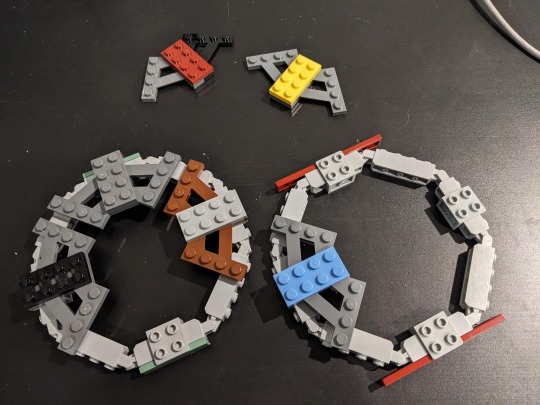
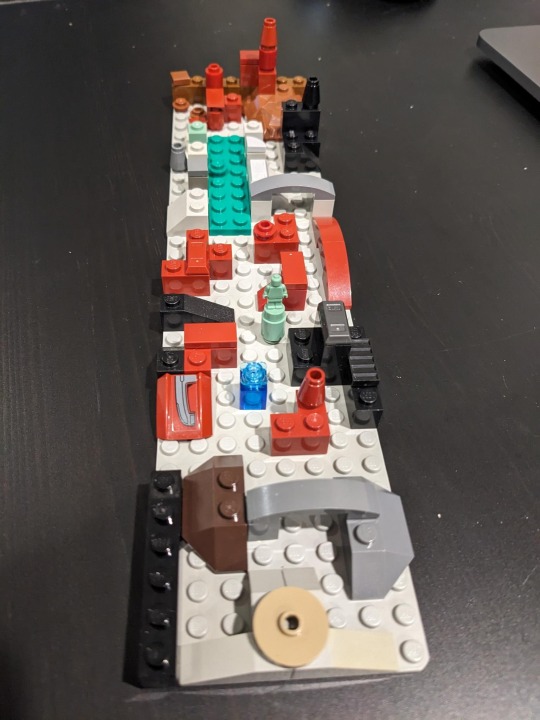
All in all, it was a lot of fun! Things that worked well/could be improved on:
The aforementioned mini stability. I should add more baseplates to the minis to making moving and standing them up less finicky.
As cool as the egg carton bottoms are, having flat surfaces is just better. Going to stick with the tops going forward.
The grid ground floor worked great. I should trace more grids onto the egg cartons and larger boxes. I also made a few measuring sticks out of dowels and that was super handy.
Witchdice on phones continues to work well for PC character sheets.
I made a handful of status tokens that we could put next to mechs. They were handy for consumable statuses like lock-on, but less so for memorable ones like exposed and hidden.
We needed more little indicators for misc systems like Javelin Rockets and Iceout Drone.
It was fun to be able to follow up "how do you want to do this" with "you may now destroy the mini".

146 notes
·
View notes
Text
Unlocking Pump Performance: Kirloskar Corrocoat's Advanced Coating Solutions

In the realm of industrial machinery, the efficiency and longevity of equipment are paramount. Every component plays a crucial role, none more so than impellers and tube sheets in pumps. Recognizing this, Kirloskar Corrocoat Private Limited has pioneered advanced coating solutions designed to enhance the performance and durability of critical pump components. Let's delve into their innovative offerings and how they are revolutionizing the industry.
Impeller Coating: Maximizing Efficiency and Durability
Impellers are the heart of pumps, responsible for propelling fluids with precision and efficiency. However, the harsh operating conditions they endure can lead to erosion, corrosion, and reduced performance over time. Kirloskar Corrocoat's Impeller Coating is engineered to combat these challenges head-on.
Utilizing state-of-the-art epoxy glass flake coatings, Kirloskar Corrocoat provides a robust protective layer that shields impellers from abrasion, chemical attack, and wear. This not only extends the lifespan of impellers but also ensures consistent performance, ultimately optimizing pump efficiency and reliability.
Pump Efficiency Improvement Coating: Enhancing Performance
Efficiency is the cornerstone of pump operation, directly impacting energy consumption and operational costs. Kirloskar Corrocoat's Pump Efficiency Improvement Coating is tailored to address inefficiencies stemming from corrosion, fouling, and hydraulic losses.
By applying specialized coatings to pump components, including casings and internal surfaces, Kirloskar Corrocoat enhances fluid flow dynamics, minimizes frictional resistance, and mitigates the effects of fouling and scaling. The result is a significant improvement in pump efficiency, translating to reduced energy consumption and operational savings for industries across the board.
Tube Sheet Coating: Protecting Critical Components
Tube sheets serve as vital components in heat exchangers and condensers, facilitating heat transfer between fluids. However, they are prone to corrosion, fouling, and pitting, jeopardizing performance and integrity. Kirloskar Corrocoat's Tube Sheet Coating provides a reliable solution to safeguard these critical components.
Through the application of epoxy glass flake coatings, Kirloskar Corrocoat creates a robust barrier against corrosion and erosion, ensuring prolonged service life and uninterrupted heat transfer efficiency. Additionally, the anti-fouling properties of the coating minimize maintenance requirements, optimizing operational uptime and productivity.
Epoxy Glass Flake Coating: Unparalleled Protection
At the core of Kirloskar Corrocoat's advanced coating solutions lies epoxy glass flake technology—a proven formulation renowned for its exceptional protective properties. This high-performance coating system offers unmatched resistance to corrosion, abrasion, and chemical attack, making it ideal for a wide range of industrial applications.
Whether applied to impellers, tube sheets, water boxes, or other critical components, epoxy glass flake coatings deliver long-lasting protection and performance enhancement. With Kirloskar Corrocoat's expertise in formulation and application, customers can trust in the reliability and durability of their equipment, even in the most challenging operating environments.
Water Box Coating: Ensuring Reliability in Cooling Systems
Water boxes play a pivotal role in cooling systems, facilitating the circulation and exchange of heat in various industrial processes. However, exposure to corrosive environments can compromise their integrity and performance. Kirloskar Corrocoat's Water Box Coating offers a proven solution to safeguard these vital components.
By applying specialized coatings engineered to withstand the rigors of cooling water environments, Kirloskar Corrocoat enhances corrosion resistance and longevity of water boxes. This not only prevents costly downtime due to maintenance and repairs but also ensures the uninterrupted operation of critical cooling systems.
Innovation and Expertise: Kirloskar Corrocoat's Commitment to Excellence
In an era where industrial reliability is non-negotiable, Kirloskar Corrocoat stands as a beacon of innovation and excellence. With a modern production facility and cutting-edge technology at Kirloskarvadi, coupled with a steadfast commitment to quality and customer satisfaction, Kirloskar Corrocoat is at the forefront of advancing coating solutions for diverse industrial applications.
Whether it's improving pump efficiency, protecting critical components, or enhancing overall equipment reliability, Kirloskar Corrocoat's comprehensive range of coatings delivers unparalleled performance and peace of mind. As industries continue to evolve, Kirloskar Corrocoat remains dedicated to empowering customers with the tools they need to thrive in a competitive landscape, one coating at a time.
#Glass Flake Coating#Internal Glass Flake Coating of Pipeline#Pump Refurbishment & Coating#Impeller Coating#Corrosion Resistance Coating#Tank Internal Coating#Water Box Coating#Tube Sheet Coating
0 notes